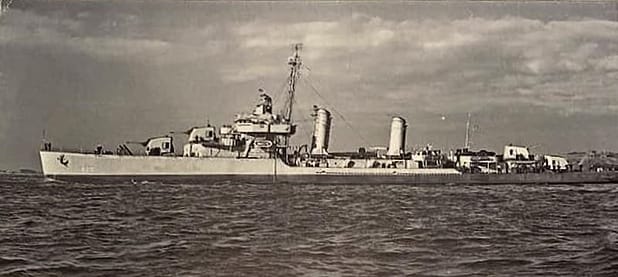
GREENVILLE – Jenny McCombs of Greenville and her family will welcome her Uncle Harley Edwin Alexander home on June 29th, 2024, 80 years after the 22-year-old Darke County Navy Sailor lost his life during D-Day serving his country in World War II.
“Harley was raised on a farm outside New Madison at the corner of Harrison and Moore Miller Road,” said McCombs. “He lived his whole life in New Madison until he enlisted in the Navy. The house is still there.”
McCombs provided DNA along with two male cousins to begin the process of identifying the remains.

“You know how you think,” Jenny said. “I thought 1944, there was not much chance they would find anything.”
“We met with a Navy Chief and an NCO, and it turns out Harley was on the USS Glennon, a destroyer,” she continued. “It was deployed in the English Channel for ground support for D-Day where they were patrolling. It was supposed to have been swept for mines, but they hit a mine. The ship didn’t completely sink then, but everything we’ve seen says Harley was lost in the first explosion. It was disabled, and the Germans used it for target practice until it sunk.”
Harley Edwin Alexander entered the military in Indianapolis, Indiana on August 4, 1942. During World War II, he served on the destroyer USS Glennon (DD-620). Alexander was killed in action when the USS Glennon, a 1,630-ton USS Gleaves-class destroyer, hit a mine on June 8, 1944. His remains were not accounted for after the war.

On June 3, 1944, the USS Glennon sailed as part of Destroyer Squadron 17, departing from Belfast, Northern Ireland, to participate in Operation NEPTUNE. Once in position off the coast of France, USS Glennon screened – or patrolled for enemy submarines – the Utah Beach landing forces from June 4-6.
Following the successful liberation of Rome and the northward push through Italy in June 1944, Allied forces succeeded in opening the “Second Front” by landing on mainland France in a campaign code-named NEPTUNE, which began on 6 June 1944, commonly referred to as “D-Day.”
The beaches of the Normandy coastline were divided into five assault-landing areas, designated “Utah,” “Omaha,” “Gold,” “Sword,” and “Juno.” In the days immediately following the successful landings, Allied troops moved inland, requiring constant reinforcement of men and materiel and offensive support from the air and seas.
On June 7, 1944, the USS Glennon began providing shore fire control support to Allied ground troops advancing towards Quinebille, France. The USS Glennon fired hundreds of rounds at German positions and helped stop the German counterattack. German artillery returned fire on the ship, landing several rounds near the vessel. On the evening of June 7, the USS Glennon continued patrolling around the shore bombardment ships while also watching for additional German attacks on landing forces.
On the morning of June 8, 1944, the USS Glennon was located approximately two miles offshore from Quenneville, France in the modern-day La Ferte region. The ship tried to maintain its position in a channel that had been swept for mines while providing close fire support to the day’s landing force. At 8:03 a.m. a mine exploded near the stern of USS Glennon with great force, sending 16 sailors into the water, some thrown as high as 40 feet.
Depth charges, gun mounts, and cement buoy anchors were also tossed into the air. Very quickly, the stern began to separate from the aft section and settle, anchoring the ship to the seafloor. General quarters was sounded as a motor boat was lowered to rescue all 16 thrown overboard. Most crew abandoned the vessel while others remained aboard for salvage operations.
After an initial inspection of the damage, it appeared that the USS Glennon was not in danger of sinking and the crew was told to remain aboard. The ship’s damage control officer determined that the mine exploded near the port propeller shaft, causing damage from the keel to the main deck. The stern had settled downward at a 30-degree angle, and the starboard propeller had anchored the ship to the channel bottom. Several compartments had flooded, but pumping was already in progress. By 9:00 a.m., a tug was called to try to move the ship.
On June 10, 1944, the ship was struck by multiple artillery barrages from the shore and sank at 2145 hours. The USS Glennon’s final casualty account from these attacks was 25 missing and 28 wounded. Other than the rescue of wounded Sailors thrown overboard during the initial mine strike and the subsequent rescue of personnel following the abandoning ship, there is no record of any wider search for the missing crew members in the immediate aftermath of the ship’s sinking. The remains of Alexander were not accounted for following this incident.
In 1957, salvagers hauled pieces of the USS Glennon to shore. A local resident was searching through the larger sections of wreckage and found human remains within the forward portion of the ship. The remains were turned over to American officials, and processing determined they belonged to at least two individuals, subsequently designated X-9296 and X-9297. After unsuccessful efforts to identify the remains, they were interred on March 4, 1959, in Ardennes American Cemetery, Neupre, Belgium.
In August 2022, the Department of Defense and the American Battle Monuments Commission exhumed unknown remains X-9296 and X-9297 from Ardennes American Cemetery for comparison with unaccounted-for sailors from the USS Glennon.
DNA testing was performed at the Armed Forces DNA Identification Laboratory (AFDIL), Armed Forces Medical Examiner System, Dover Air Force Base, DE. Testing included mtDNA, which traces the maternal (mother’s) line; DNA from the Y chromosome (Y-STR), which traces the paternal (father’s) line; and autosomal DNA (auSTR), which is individual specific to identify the remains positively.
Today, Alexander is memorialized on the Wall of the Missing at Cambridge American Cemetery, Cambridge, England.
“I am glad this happened while some of our generation is still here,” Jenny said. “We always heard about Uncle Harley. Grandma had four sons serving in World War II at the same time. Lloyd and Bob were in the Army. Harley and Howard were in the Navy, and the other three came home.”
“They gave us the option that Harley could be buried in a National Cemetery or we could bring him home and all of us want to bring him home. We found out in this meeting that Grandma had written a letter to the government and the Navy and asked for a memorial stone. They said since he was missing and not declared dead, they weren’t allowed to do that, so the family took up a collection and purchased a stone because there has always been a stone there.”
“When I was a little girl, they always got together on Memorial Day, brought their peonies, lilacs, and iris, and decorated the graves. Uncle Harley has always had a stone right beside his mother so that is where the body will be buried.”
“When we met with the Mitary they asked if we were going to have a ceremony. I believe he deserves all the honor. He’s gone 80 years without that honor. He has a cross in a cemetery in Europe.”
“I’m glad we can finally lay him to rest,” Jenny concluded.


